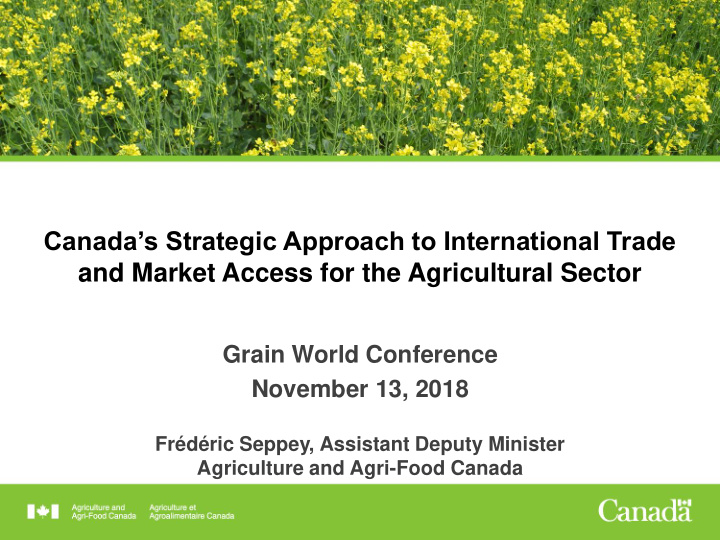



Canada’s Strategic Approach to International Trade and Market Access for the Agricultural Sector Grain World Conference November 13, 2018 Frédéric Seppey, Assistant Deputy Minister Agriculture and Agri-Food Canada
Framework for Growing Agriculture Exports Canada’s Objective: Grow agriculture and agri-food exports to at least $75 billion annually by 2025 Key Question: How do we meet our objective? Strategy: Establish, influence, maintain, and enforce rules across various fora, while also pursuing trade diversification 2
Canada is a Trading Nation FTAs in Force Signed FTAs Ongoing FTA Negotiations Ongoing Exploratory FTA Discussions
The Global Trade Context is Challenging • Rapid changes and uncertainty; protectionism is re- emerging • Challenges to the rules-based international system • Non-tariff barriers disrupt trade and undermine market access • Free Trade Agreements (FTAs) between other countries can place Canadian exports at a competitive disadvantage A multi-pronged approach is needed 4
Canada Has Many Trade Policy Levers Key Question: How do we meet our objectives? Setting the Rules (WTO, FTAs) Enforcing the Rules (Dispute Settlement, Trade Remedies, Safeguards, WTO Committees) Promoting and Defending Science-Based Regulations (International Standard Setting Bodies, Advocacy) Leveraging Multilateral Institutions (FAO, G7, G20, APEC) 5
United States-Mexico-Canada Agreement (USMCA) • Agreement on September 30, 2018 FTAs: Setting the Rules • Will preserve existing agriculture commitments between all USMCA Parties • Once implemented, the USMCA will further bring together an already highly integrated industry • Maintains duty-free trade, achieves ambitious disciplines related to agricultural biotechnology, and establishes a modernized SPS chapter 6
Transformational FTAs ( CETA, CPTPP) Recent agreements open doors FTAs: Setting the Rules • Better market access for sector – Achieved by addressing tariff and non-tariff barriers Canada has an edge • Leveraging opportunities can grow exports • First mover advantage over competitors Strategic Actions • Advocacy work to assist sector in realizing significant market access gains • Maintain/Expand market access gains when opportunities arise (e.g., CETA-UK/Brexit; future CPTPP accessions) 7
Trade Diversification Canada looking beyond existing FTA partners FTAs: Setting the Rules • Broad FTA agenda • FTAs with growing/emerging markets • Agreements with non-traditional partners Necessary due to uncertain trading environment • Cannot rely on one large trading partner • Preferential access to emerging markets as a competitive advantage Strategic Actions • Exploratory discussions and FTA negotiations • Scale of agricultural market access gains (and trade-offs) • Ambition in rule-making (WTO + obligations) 8
International Rules and Trade in Agricultural Products WTO is the lynchpin of the global trading system WTO: Setting the Rules The Agreement on Agriculture is the only forum to address • Trade or production distorting domestic support • Export subsidies, export financing, agriculture exporting STEs, international food aid Strategic Actions • Ongoing monitoring via notifications, questions on recent policy developments, and working with like-minded WTO Members. 9
WTO is a Forum to Change Rules and Level the Field Nairobi Decision on Export Competition WTO: Setting the Rules • Eliminated export subsidies • Established new rules on export financing • New requirements for agriculture exporting state trading enterprises • Prevent commercial displacement by international food aid Strategic Actions • Domestic support – limit future distortions • Export competition – ensure international rules are fair • Market access - no new layers of protection 10
Settling Disputes Can Be Required Objectives: • Use formal dispute settlement through the WTO or FTAs as Enforcing the Rules an option of last resort • Other options include: anti-dumping action, countervailing duty measures, and global safeguards Priorities: • U.S. imposition of steel and aluminum tariffs Results: • U.S. mandatory Country of Origin Labelling (2008-2016) • EU biotech dispute 11
International Rules Based on Scientific Evidence are Fundamental to Global Trade Non-scientific factors create trade barriers and/or Science-Based Regulations Promoting and Defending block new international standards Pressures make unscientific decisions more likely • Innovation in agriculture is key but the pace puts stress on regulatory authorities • Consumers are preoccupied with production practices and possible impacts on health and the environment • Unscientific reports influence consumer opinion Strategic Actions • Influence the development of science and evidence-based standards • Ensure the integrity of the technical trading system • Collaborate to develop approaches to technical issues (e.g., regulatory compliance, lack of harmonization) 12
Aligning Regulations Facilitates Trade Progress is made in different fora Science-Based Regulations Promoting and Defending International Plurilateral Initiatives International Standard Setting Bodies (ISSBs) Institutions and Advocacy • CODEX • OECD • Global Low Level Presence Initiative (GLI) • International Plant • Convention on Biological • MRL coalition work Protection Convention Diversity • World Organization for • Food and Agriculture • Like-Minded Group on Animal Health Organization of the Innovative Agricultural United Nations Technologies • FAO/WHO • WTO Strategic Actions • GLI – 6 international meetings to advance trade-facilitative approaches to managing LLP • ISSB Engagement – advanced scientific work of the Codex meeting on pesticide residues to support adoption of pesticide MRLs • Pesticide MRLs – continue to work with industry, international institutions and countries to address missing and misaligned MRLs 13
Multilateral Advocacy Furthers Canadian Aims Leveraging Multilateral Institutions Multilateral institutions provide another forum • Advocate science-based approaches to benefit developing countries, protect environment at G20, FAO, APEC, IICA, G7 • Invest financial and technical contributions to leverage multilateral organizations’ impartiality, expertise and networks to inform countries about science-based trade, and pursue projects that solve problems Strategic Actions • FAO – share information, best practices, support Codex (e.g., science advisory panel) • G20 – advocate open agri-food trade to fight global poverty and hunger • APEC, FAO, others – projects encouraging science-based approaches 14
Key Questions • In looking to Canada’s $75 billion export target by 2025: – Are there areas where government activity needs to be increased/lessened? – Are you adjusting your approaches and strategies to fully seize new opportunities? 15
Thank You 16
Recommend
More recommend